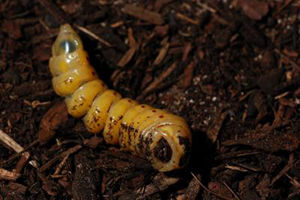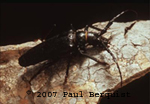Animal Fact Sheet: Palo Verde Root Borer Beetle grub |
|
Identifying Features The photo to the right is the larval stage of what will become a Palo verde root borer beetle (Derobrachus germinatus) pictured below.
The larvae or grubs are creamy white in color. Adult borer beetles look like a large cockroach. They have long antennae, and spines on their thorax. They range from brown to black in color. They have wings and can fly. |
 |
Adaptations The beetles have adapted to live not only in native trees but non-native trees as well. They may be found in rose and olive, as well as Mexican Palo Verde. |
Habitat The female beetle lays her eggs in the soil near the roots of trees. When the eggs hatch the larvae will bore into the roots of the trees and begin to eat it them. The larvae may take two to four years to become an adult beetle. |
Range Similar species are found throughout the southwest, but the commonly seen species live near Phoenix and Tucson, Arizona. |
Wild Status Currently they are not threatened or endangered. |
Diet The grubs will eat the woody tissue of the tree roots. Adult beetles may take nectar or feed on fruit. |
Predators Predators of adult beetles include roadrunners, owls, coyotes and bobcats. The grubs are eaten by coati, skunk and possibly bears. |
Home The home of the grubs is tree roots. Adults fly about to find mates. The female may nest in the area where she emerged from her larval stage. |
Life Span The grubs can live in the tree roots for 3-4 years. Adult beetles die soon after mating, making their life span about one month. |
Size The larvae or grub can reach 5 inches in length. The adult beetle is 3-3.5 inches long. |
Quick Facts
|
 ©Copyright 2008, Arizona-Sonora Desert Museum
©Copyright 2008, Arizona-Sonora Desert Museum











